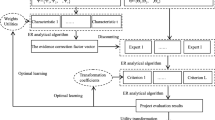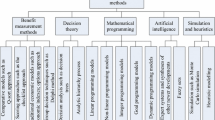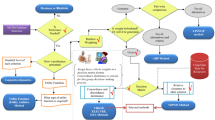Abstract
Research project evaluation and selection is mainly concerned with evaluating a number of research projects and then choosing some of them for implementation. It involves a complex multiple-experts multiple-criteria decision making process. Thus this paper presents an effective method for evaluating and selecting research projects by using the recently-developed evidential reasoning (ER) rule. The proposed ER rule based evaluation and selection method mainly includes (1) using belief structures to represent peer review information provided by multiple experts, (2) employing a confusion matrix for generating experts’ reliabilities, (3) implementing utility based information transformation to handle qualitative evaluation criteria with different evaluation grades, and (4) aggregating multiple experts’ evaluation information on multiple criteria using the ER rule. An experimental study on the evaluation and selection of research proposals submitted to the National Science Foundation of China demonstrates the applicability and effectiveness of the proposed method. The results show that (1) the ER rule based method can provide consistent and informative support to make informed decisions, and (2) the reliabilities of the review information provided by different experts should be taken into account in a rational research project evaluation and selection process, as they have a significant influence to the selection of eligible projects for panel review.





Similar content being viewed by others
References
Agarski, B., Budak, I., Kosec, B., & Hodolic, J. (2012). An approach to multi-criteria environmental evaluation with multiple weight assignment. Environmental Modeling and Assessment, 17(3), 255–266.
Bulathsinhala, N. A. (2014), Ex-ante evaluation of publicly funded R&D projects: Searching for exploration. Science and Public Policy, scu035, 1-14.
Carlsson, C., Fullér, R., Heikkilä, M., & Majlender, P. (2007). A fuzzy approach to R&D project portfolio selection. International Journal of Approximate Reasoning, 44(2), 93–105.
Chen, X. T. (2009). National science fund and management sciences (1986–2008). Beijing: Science Press.
Coffin, M. A., & Taylor, B. W, I. I. I. (1996). Multiple criteria R&D project selection and scheduling using fuzzy logic. Computers & Operations Research, 23(3), 207–220.
Feng, B., Ma, J., & Fan, Z. P. (2011). An integrated method for collaborative R&D project selection: Supporting innovative research teams. Expert Systems with Applications, 38(5), 5532–5543.
Henriksen, A. D., & Traynor, A. J. (1999). A practical R&D project-selection scoring tool. IEEE Transactions on Engineering Management, 46(2), 158–170.
Horrobin, D. F. (1996). Peer review of grant applications: A harbinger for mediocrity in clinical research? The Lancet, 348(9037), 1293–1295.
Hsu, Y. G., Tzeng, G. H., & Shyu, J. Z. (2003). Fuzzy multiple criteria selection of government-sponsored frontier technology R&D projects. R&D Management, 33(5), 539–551.
Huang, C. C., Chu, P. Y., & Chiang, Y. H. (2008). A fuzzy AHP application in government-sponsored R&D project selection. Omega, 36(6), 1038–1052.
Jayasinghe, U. W., Marsh, H. W., & Bond, N. (2006). A new reader trial approach to peer review in funding research grants: An Australian experiment. Scientometrics, 69(3), 591–606.
Južnič, P., Pečlin, S., Žaucer, M., Mandelj, T., Pušnik, M., & Demšar, F. (2010). Scientometric indicators: Peer-review, bibliometric methods and conflict of interests. Scientometrics, 85(2), 429–441.
Khalili-Damghani, K., Sadi-Nezhad, S., & Tavana, M. (2013). Solving multi-period project selection problems with fuzzy goal programming based on TOPSIS and a fuzzy preference relation. Information Sciences, 252, 42–61.
Lawson, C. P., Longhurst, P. J., & Ivey, P. C. (2006). The application of a new research and development project selection model in SMEs. Technovation, 26(2), 242–250.
Linton, J. D., Walsh, S. T., & Morabito, J. (2002). Analysis, ranking and selection of R&D projects in a portfolio. R&D Management, 32(2), 139–148.
Mahmoodzadeh, S., Shahrabi, J., Pariazar, M., & Zaeri, M. S. (2007). Project selection by using fuzzy AHP and TOPSIS technique. World Academy of Science, Engineering and Technology, 30, 333–338.
Meade, L. M., & Presley, A. (2002). R&D project selection using the analytic network process. IEEE Transactions on Engineering Management, 49(1), 59–66.
Olsson, N. O., Krane, H. P., Rolstadås, A., & Veiseth, M. (2010). Influence of reference points in ex post evaluations of rail infrastructure projects. Transport Policy, 17(4), 251–258.
Oral, M., Kettani, O., & Çınar, Ü. (2001). Project evaluation and selection in a network of collaboration: A consensual disaggregation multi-criterion approach. European Journal of Operational Research, 130(2), 332–346.
Provost, F., & Kohavi, R. (1998). Guest editors’ introduction: On applied research in machine learning. Machine Learning, 30(2), 127–132.
Shafer, G. (1976). A mathematical theory of evidence (Vol. 1). Princeton: Princeton University Press.
Silva, T., Guo, Z., Ma, J., Jiang, H., & Chen, H. (2013). A social network-empowered research analytics framework for project selection. Decision Support Systems, 55(4), 957–968.
Silva, T., Jian, M., & Chen, Y. (2014). Process analytics approach for R&D project selection. ACM Transactions on Management Information Systems (TMIS), 5(4), 21.
Smarandache F, Dezert J, Tacnet J. (2010). Fusion of sources of evidence with different importances and reliabilities. In: 2010 13th conference on information fusion (FUSION). IEEE (pp. 1–8).
Solak, S., Clarke, J. P. B., Johnson, E. L., & Barnes, E. R. (2010). Optimization of R&D project portfolios under endogenous uncertainty. European Journal of Operational Research, 207(1), 420–433.
Tavana, M., Khalili-Damghani, K., & Sadi-Nezhad, S. (2013). A fuzzy group data envelopment analysis model for high-technology project selection: A case study at NASA. Computers & Industrial Engineering, 66(1), 10–23.
Tian, Q., Ma, J., Liang, J., Kwok, R. C., & Liu, O. (2005). An organizational decision support system for effective R&D project selection. Decision Support Systems, 39(3), 403–413.
Wang, J., & Hwang, W. L. (2007). A fuzzy set approach for R&D portfolio selection using a real options valuation model. Omega, 35(3), 247–257.
Wang, D. P., Zhu, W. D., Chen, B., & Liu, F. (2015). Analysis of the expert judgments in the NSFC peer review from the perspective of human cognition: A research based on the ER rule. Science of science and management of S. & T., 36(4), 22–35.
Xu, D. L. (2012). An introduction and survey of the evidential reasoning approach for multiple criteria decision analysis. Annals of Operations Research, 195(1), 163–187.
Yang, J. B. (2001). Rule and utility based evidential reasoning approach for multiattribute decision analysis under uncertainties. European Journal of Operational Research, 131(1), 31–61.
Yang, J. B., & Singh, M. G. (1994). An evidential reasoning approach for multiple-attribute decision making with uncertainty. IEEE Transactions on Systems, Man and Cybernetics, 24(1), 1–18.
Yang, J. B., & Xu, D. L. (2002). On the evidential reasoning algorithm for multiple attribute decision analysis under uncertainty. IEEE Transactions on Systems, Man, and Cybernetics Part A: Systems and Humans, 32(3), 289–304.
Yang, J. B., & Xu, D. L. (2013). Evidential reasoning rule for evidence combination. Artificial Intelligence, 205, 1–29.
Acknowledgments
This research is partially supported by the National Natural Science Foundation of China under Grant No. 71071048 and the Scholarship from China Scholarship Council under Grant No. 201306230047.
Author information
Authors and Affiliations
Corresponding author
Appendices
Appendix 1: Reliabilities of experts for “Results and comparative analysis” section
As the reliabilities of some experts are not available in the data set, the average true positive rate of 0.2726 and the average true negative rate of 0.9592 are used as their reliabilities accordingly.
No. of projects | Negative | Positive | TN | TP | True positive rate | True negative rate | |
|---|---|---|---|---|---|---|---|
Project 1/Expert 1 | 2 | 2 | 0 | ||||
Expert 2 | 12 | 5 | 7 | 4 | 0 | 0.8 | |
Expert 3 | 11 | 9 | 2 | 7 | 1 | 0.5 | 0.7778 |
Expert 4 | 19 | 4 | 15 | 4 | 6 | 0.4 | 1 |
Expert 5 | 4 | 1 | 3 | 1 | 0 | 1 | |
Project 3/Expert 1 | 11 | 8 | 3 | 5 | 0 | 0.625 | |
Expert 2 | 11 | 6 | 5 | 6 | 1 | 0.2 | 1 |
Expert 3 | 18 | 3 | 15 | 3 | 4 | 0.2667 | 1 |
Expert 4 | 15 | 11 | 4 | 11 | 1 | 0.25 | 1 |
Expert 5 | 10 | 4 | 6 | 4 | 0 | 1 | |
Project 4/Expert 1 | |||||||
Expert 2 | 15 | 4 | 11 | 4 | 1 | 0.0910 | 1 |
Expert 3 | 16 | 13 | 3 | 12 | 0 | 0.9231 | |
Expert 4 | 7 | 1 | 6 | 1 | 3 | 0.5 | 1 |
Expert 5 | 12 | 7 | 5 | 7 | 2 | 0.4 | 1 |
Project 5/Expert 1 | |||||||
Expert 2 | |||||||
Expert 3 | |||||||
Expert 4 | 6 | 1 | 5 | 1 | 0 | 1 | |
Expert 5 | 7 | 5 | 2 | 5 | 1 | 0.5 | 1 |
Project 6/Expert 1 | |||||||
Expert 2 | 14 | 4 | 10 | 4 | 3 | 0.3 | 1 |
Expert 3 | 18 | 2 | 16 | 2 | 3 | 0.1875 | 1 |
Expert 4 | |||||||
Expert 5 | 12 | 5 | 7 | 5 | 4 | 0.5714 | 1 |
Project 7/Expert 1 | |||||||
Expert 2 | 3 | 1 | 2 | 1 | 2 | 1 | 1 |
Expert 3 | 23 | 7 | 16 | 7 | 3 | 0.1875 | 1 |
Expert 4 | |||||||
Expert 5 | |||||||
Project 8/Expert 1 | 15 | 11 | 4 | 11 | 1 | 0.25 | 1 |
Expert 2 | 18 | 3 | 15 | 3 | 4 | 0.2667 | 1 |
Expert 3 | 11 | 6 | 5 | 6 | 1 | 0.2 | 1 |
Expert 4 | 10 | 4 | 6 | 4 | 0 | 1 | |
Expert 5 | 11 | 8 | 3 | 5 | 0 | 0.625 | |
Project 9/Expert 1 | 10 | 2 | 8 | 2 | 3 | 0.375 | 1 |
Expert 2 | 11 | 5 | 6 | 4 | 2 | 0.3333 | 0.8 |
Expert 3 | 5 | 1 | 4 | 1 | 1 | 0.25 | 1 |
Expert 4 | 20 | 6 | 14 | 6 | 6 | 0.4286 | 1 |
Expert 5 | 11 | 8 | 3 | 5 | 0 | 0.625 | |
Project 10/Expert 1 | 18 | 3 | 15 | 3 | 4 | 0.2667 | 1 |
Expert 2 | 15 | 11 | 4 | 11 | 1 | 0.25 | 1 |
Expert 3 | 11 | 8 | 3 | 5 | 0 | 0.625 | |
Expert 4 | 10 | 4 | 6 | 4 | 0 | 1 | |
Expert 5 | 11 | 6 | 5 | 6 | 1 | 0.2 | 1 |
Appendix 2
Expert 1 | Expert 2 | Expert 3 | Expert 4 | Expert 5 | |
|---|---|---|---|---|---|
Original evaluation information of project R 2 by experts | |||||
Comprehensive evaluation level | Average | Good | Poor | Excellent | Excellent |
Funding recommendation | Not fund | Fund | Not fund | Fund with priority | Fund |
Expert 1 | Expert 2 | Expert 3 | Expert 4 | Expert 5 | |
|---|---|---|---|---|---|
Original evaluation information of project R 3 by experts | |||||
Comprehensive evaluation level | Average | Good | Good | Good | Average |
Funding recommendation | Fund | Fund | Fund | Fund | Fund |
Experts | Projects | Negative | Positive | TN | TP | True positive rate | True negative rate | |
|---|---|---|---|---|---|---|---|---|
Reliabilities of experts for project R 2 and R 3 | ||||||||
Project R 2 | Expert 3 | 13 | 4 | 9 | 4 | 4 | 0.4444 | 1 |
Project R 3 | Expert 3 | 19 | 6 | 13 | 6 | 6 | 0.461538462 | 1 |
Expert 5 | 12 | 2 | 10 | 2 | 3 | 0.3 | 1 | |
Rights and permissions
About this article
Cite this article
Zhu, Wd., Liu, F., Chen, Yw. et al. Research project evaluation and selection: an evidential reasoning rule-based method for aggregating peer review information with reliabilities. Scientometrics 105, 1469–1490 (2015). https://doi.org/10.1007/s11192-015-1770-8
Received:
Published:
Issue Date:
DOI: https://doi.org/10.1007/s11192-015-1770-8




